Trackhoe (Excavator) vs. Backhoe (2025 Comparison)
For excavation and construction projects, picking the right equipment is vital. It leads to efficient and successful outcomes. Two common options are trackhoes and backhoes. Both are powerful machines designed for digging. But, they have key differences that make them better for specific jobs:
The main difference between a trackhoe and a backhoe lies in their design and application. A trackhoe, also known as an excavator (with tracks), is a heavy-duty machine with a rotating cab and tracks for superior digging power and stability on uneven terrain. Backhoes are smaller, wheeled machines with a two-way digging arm suitable for lighter excavation tasks and projects requiring more versatility.
The track hoe is better for digging through hard materials, while the backhoe is better for digging in narrower areas. Farmers use backhoes more often than they use larger track hoes. Construction operations find track hoes more efficient.
But you should base your decision on the specific features that fit your needs. In this article, you’ll find how the track hoe and the backhoe compare in engine output, hydraulic capacity, digging depth, and even average prices.
By the end of this post, you’ll even know the best use cases for each one. So continue reading to learn more.
Trackhoe vs. Backhoe Comparison Table
Our backhoe vs. trackhoe comparison table lays out the key differences to help you make an informed decision. So dive into the detailed specs and we’ll break it all down after that.
| Aspect | Trackhoe (Excavator) | Backhoe |
|---|---|---|
| Weight | 30,000 to 80,000 lbs | 15,000 lbs |
| Width | 11.5 feet – 22 feet | 6 feet |
| Engine | 75 HP to 120 HP | 70 to 85 HP |
| Hydraulic Total | 55 – 150 GPM | 16 – 21 GPM |
| Price | $90,000 – $500,000 | $15,000 – $80,000 |
| Digging Depth | 18 to 26 feet | 13 to 16 feet |
| Ideal Use Case | Demolition and large scale development | Small-scale construction or large-scale farm-related use |
A track hoe is a tracked excavator. Technically a mini excavator can be a track hoe as well, but the term usually refers to standard excavators are track hoes. It has an excavating bucket, a boom, and a front arm that connects the bucket to the boom.
A track hoe is used for heavy-duty digging and material handling and is common in sites that require over 20 feet of digging per pass. It is impossible to build a skyscraper without using track hoes.
A backhoe is a machine with two arms. It looks like a tractor with a front bucket facing forward and a small boom and bucket-digging mechanism at the back. It is smaller than a standard track hoe but is larger than mini excavators.
A backhoe can do everything that a track hoe does but on a smaller scale and for lower-impact use cases. Let’s look at how it differs from the track hoe in more specific ways.
Weight
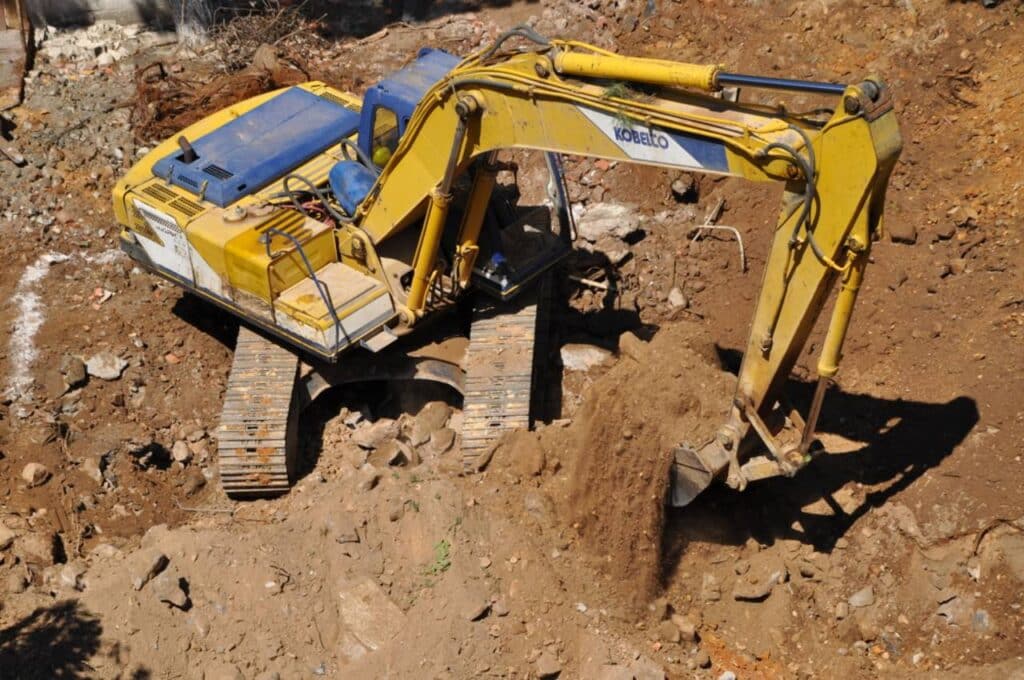
In terms of weight, neither piece of machinery is inherently superior because being heavy and being light have their own respective advantages.
With the weight of backhoes ranging from 12,000 to 15,000, and that of track hoes being between 30,000 and 80,000 lbs, it is pretty clear that a backhoe is easier to transport from site to site.
In comparison, a track hoe is pretty heavy machinery that starts at twice the weight. If it is being moved to a job site, the contractor has to be really sure that it is the best option and that its work cannot be done feasibly by a backhoe or a mini excavator.
Width

On average, a track hoe is twice as wide as a backhoe. Both machines have ranges of width, but the track hoe range starts and ends at higher values than that of a backhoe.
This gives the track hoe the advantage of getting more demolishing and digging done in a larger area.
The backhoe, however, is at an advantage when the digging work is in a tunnel that isn’t as wide as a track hoe.
Again, this isn’t an inherent advantage for either machine. There are contexts where being too wide can be a problem and also ones where being too narrow is an issue.
For farm work, being too narrow isn’t as often an issue. So a backhoe is better than a larger track hoe.
Engine
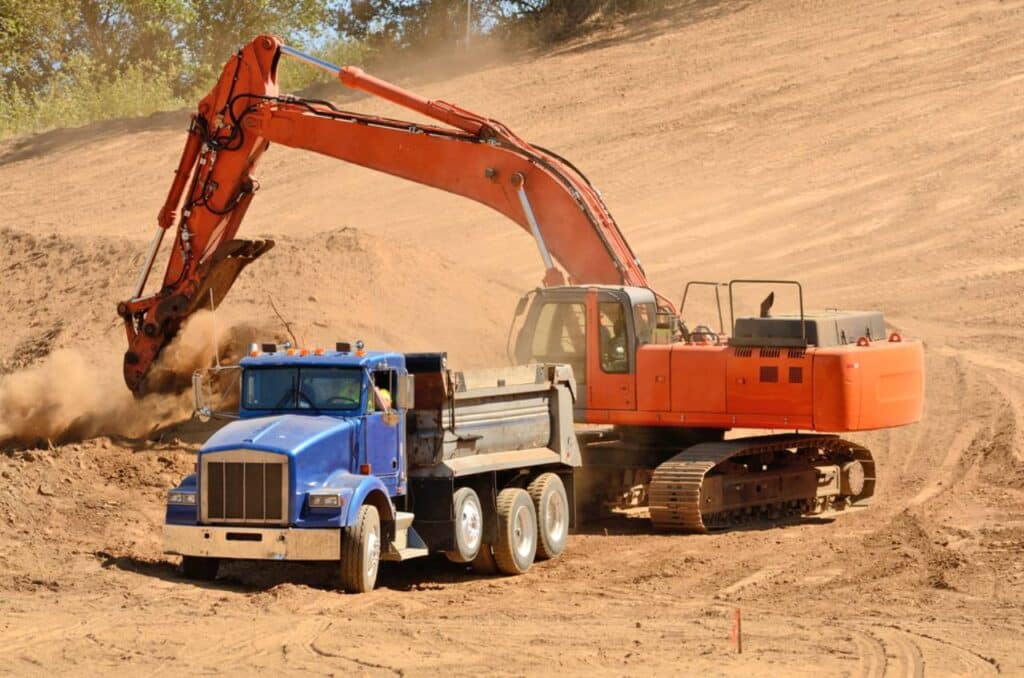
The backhoe’s engine is more powerful than a mini excavator but nowhere near as powerful as that of a standard track hoe.
If mini excavators are excluded from the track hoe umbrella, the weakest track hoe engine is more powerful than the strongest backhoe engine.
At the 75 HP to 120 HP range, the track hoe has a clear advantage over the backhoe, which has a 70 to 85 HP range. All the lifting work that a backhoe can do, a track hoe can do as well.
But the kind of digging and loading that high-end track hoes do is out of backhoes’ capability range.
The engine determines the overall movement output. It is the hydraulics that determines the digging and carrying effectiveness. But the horsepower difference between track hoes and backhoes sets the stage for a similar contrast in their hydraulics.
After all, it makes no sense to have high-capacity hydraulics on weak engines and vice versa.
Hydraulic Total
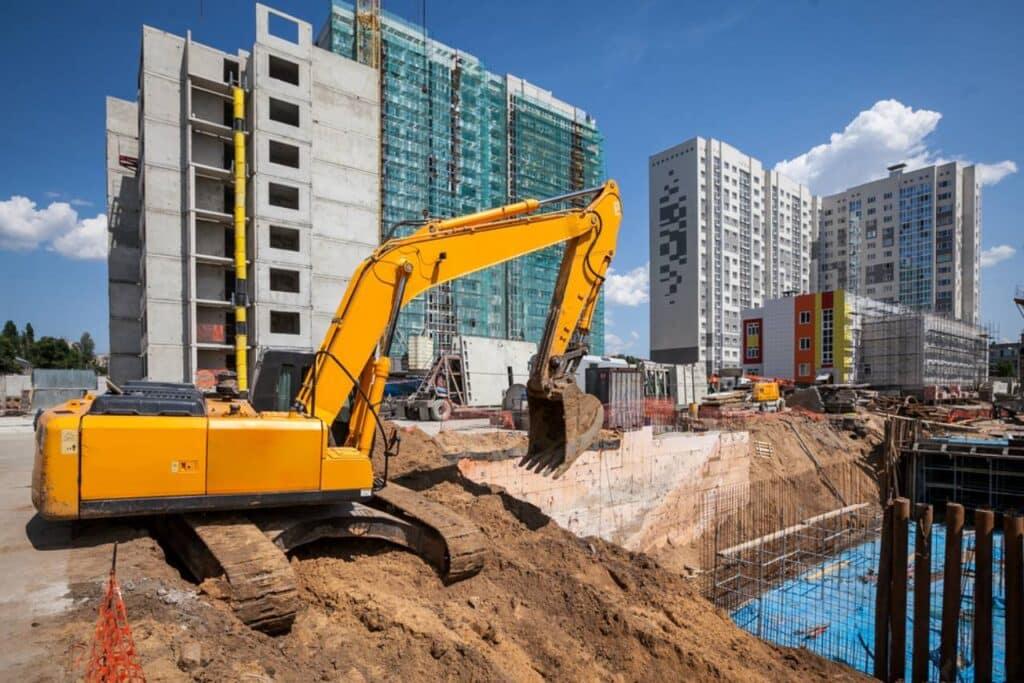
Just like with engine output, the hydraulic total of track hoes is higher than that of backhoes. On average, track hoes have twice as much hydraulic fluid flow per minute as backhoes.
Backhoes have a hydraulic fluid flow of 16 to 21 GPM, while track hoes can have up to 150 GPM.
In other words, track hoes can dig through harder surfaces and carry more weight on their loader buckets than backhoes. With a hydraulic total more than twice as big as that of a backhoe, the track hoe is a clear winner.
Price
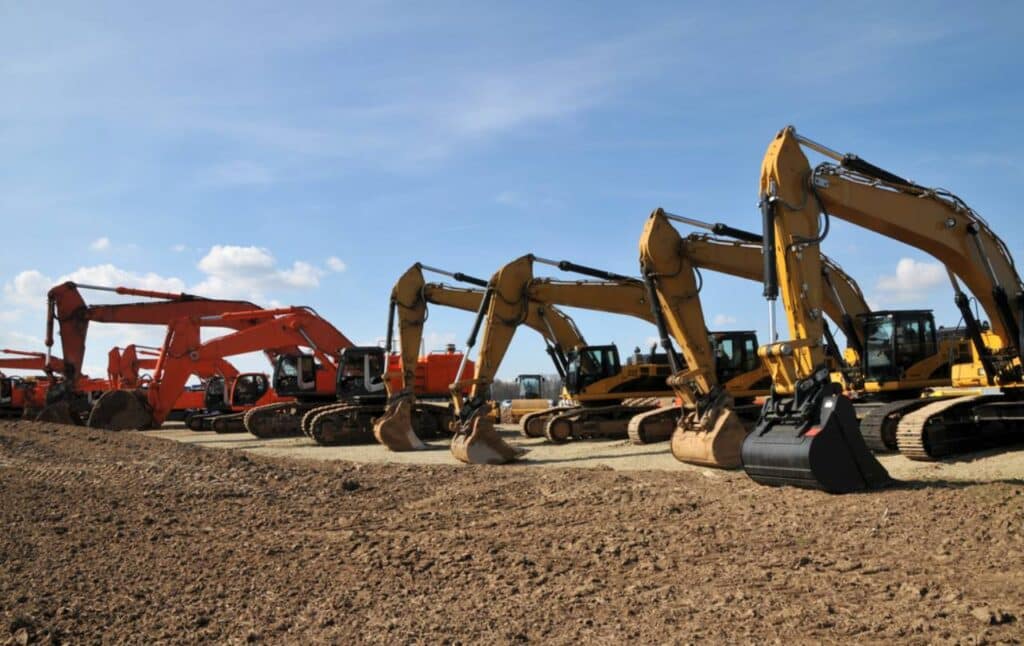
The track hoe is more expensive than a backhoe, so the backhoe has an advantage. Unless the work required cannot be done by a backhoe, it remains the better choice for most customers.
That said, there are plenty of use cases where a backhoe is really inefficient, and that’s where the price difference is justified.
Digging Depth
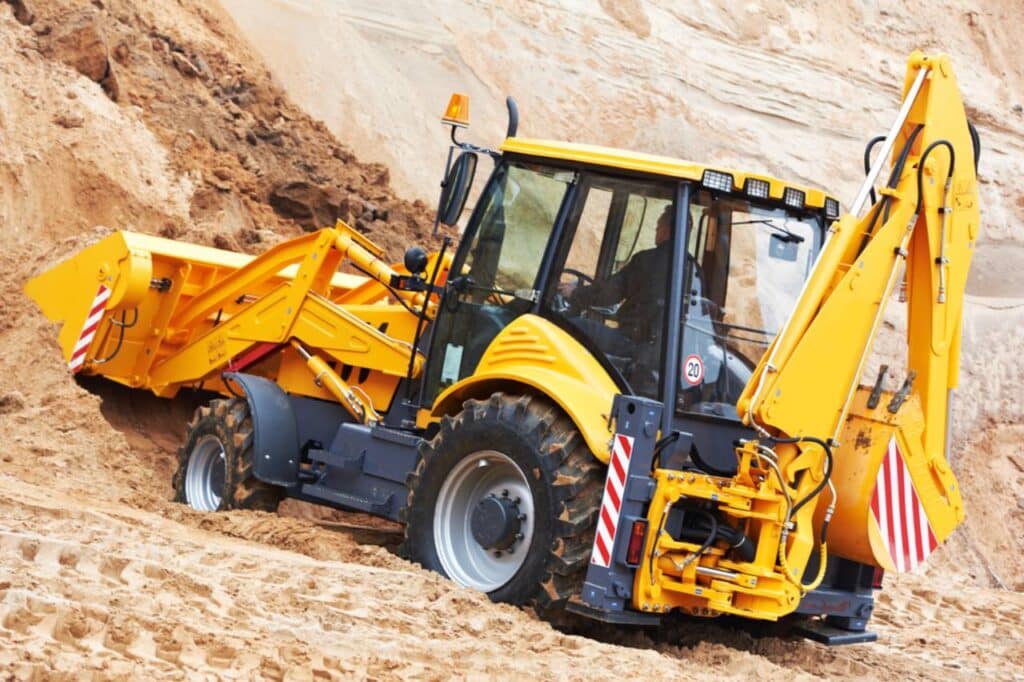
While backhoes aren’t known for digging precision, they do have a better digging-minimum than a track hoe. Both backhoe and track hoe would break pipes and wires beneath the surface, though.
So, despite giving you more control over how shallow you want to dig, a backhoe doesn’t present a significant advantage. For shallow digging, a mini excavator would be better than a backhoe.
Special Features
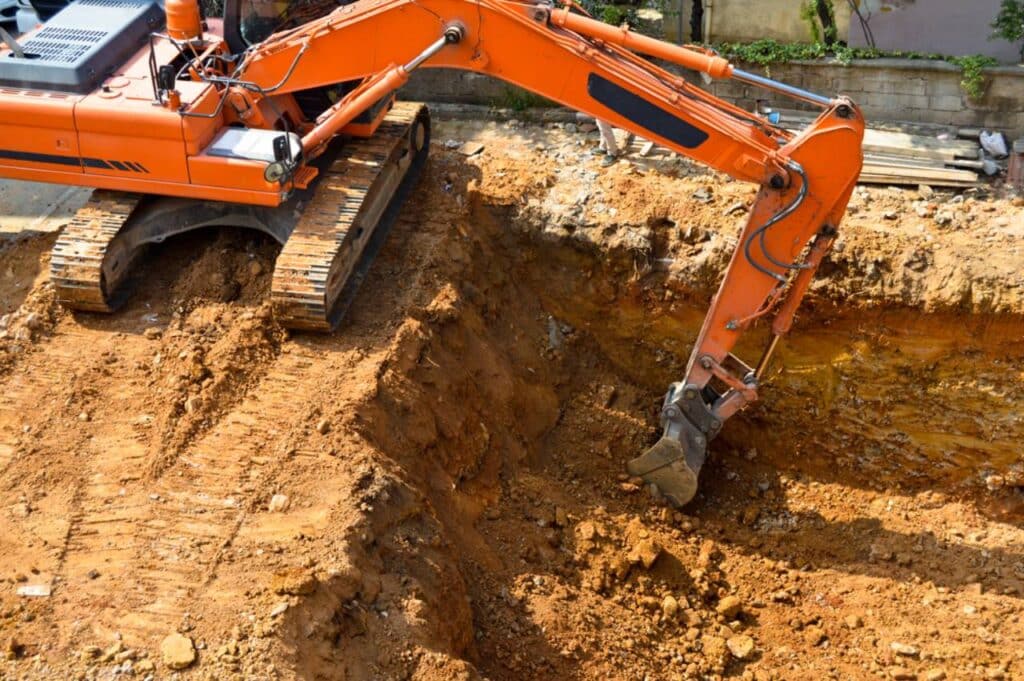
A track hoe’s comparative specialty is in its higher brute strength across all aspects. It can also rotate 360 degrees.
A backhoe’s specialty is that it has two arms and can dig narrower and shallower than a track hoe. Here’s how that can translate to different use cases.
- For construction – The higher horsepower, digging depth, and hydraulic total of the track hoe make it better for construction-related demolition and digging.
- For farming – A backhoe’s lower price makes it better for farmers, at least when compared to that of a track hoe.
- For open-pit mining – The digging depth of a track hoe makes it the more efficient one of the two machines. In open-pit mining, the narrowness of the backhoe doesn’t present a significant advantage.
- For tunnels – The narrowness of the backhoe makes it better than a track hoe at digging tunnels and operating in narrow project sites.
- For material handling – For heavy materials, the track hoe is better because of its higher hydraulic capacity.
- For digging – For circular digging, a track hoe is better since it can rotate 360 degrees. For deep digging, the track hoe’s arm length and digging depth are much better suited.
Which One Should You Use, Trackhoe or Backhoe?

If the work you plan to do can be done by a backhoe, get a backhoe. Almost no advantage of a track hoe justifies its price for someone who doesn’t professionally dig for construction sites or open-pit mines.
Only if the work you need is impossible or inefficient with a backhoe should you invest in a track hoe.
Conclusion: Tracked Excavator vs. Backhoe
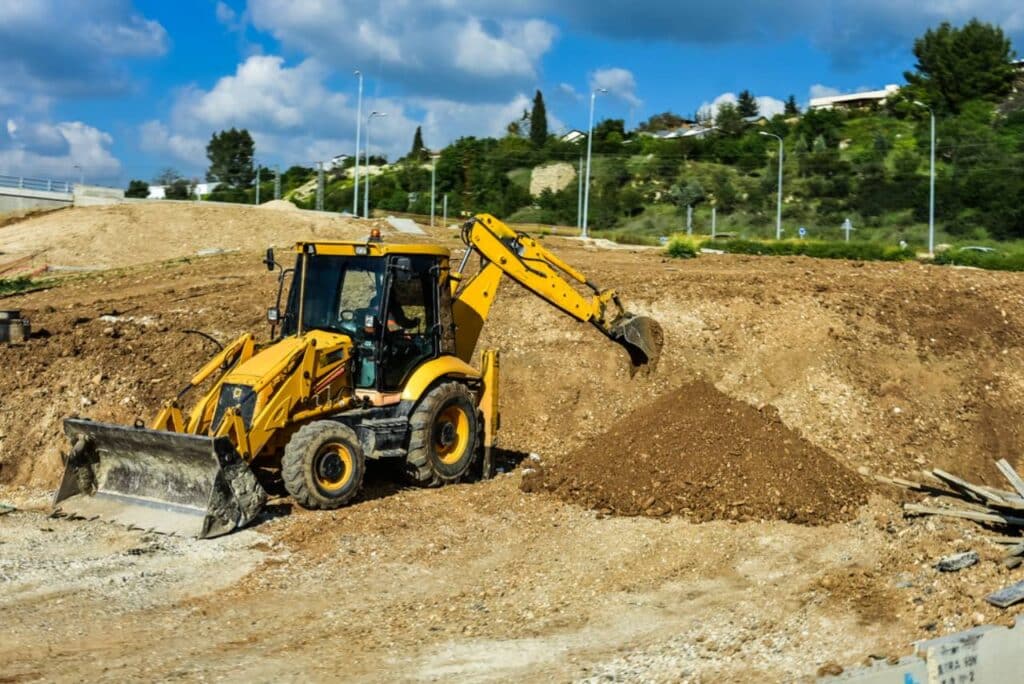
Trackhoes are powerful excavating and material handling machines, while backhoes are digging and material handling vehicles with almost half the performance output and 3 to 4 times lower price tag.
Where track hoes are essential for large construction sites, road demolition, and open-pit mining, backhoes are essential for large farms, medium-width tunneling, and small-scale construction.
FAQ
Are a backhoe and trackhoe the same thing?
A backhoe and a trackhoe are not the same thing, although they share similarities. A backhoe is a type of construction equipment that consists of a digging bucket or arm mounted on the rear of a tractor or loader. A trackhoe, on the other hand, is another term for an excavator, a different type of construction machine that typically has tracks or crawler treads and a rotating cab for precise digging and earthmoving. While both can perform digging tasks, they have distinct designs and capabilities.
Which is better backhoe or excavator?
The choice between a backhoe and an excavator depends on the specific job requirements. Backhoes are versatile for tasks like digging trenches and small excavation projects, and they can also be used as loaders. Excavators, including trackhoes, excel at precision digging and are ideal for larger-scale excavation, grading, and earthmoving projects.
Why is it called a trackhoe?
The term “trackhoe” is a colloquial combination of two words: “track” and “hoe.” It is used to describe an excavator, a type of construction equipment. The “track” part refers to the undercarriage of the machine, which typically consists of tracks or crawler treads, providing stability and mobility. The “hoe” refers to the machine’s primary digging component, the excavator bucket or arm. Thus, “trackhoe” simply denotes an excavator with a tracked undercarriage.
What are the uses of Trackhoe?
Trackhoes, or tracked excavators, are versatile construction machines used for various tasks such as digging, trenching, excavating, grading, material handling, and demolition. They are commonly employed in construction, mining, landscaping, and utility work due to their ability to efficiently perform precision digging and earthmoving operations.

